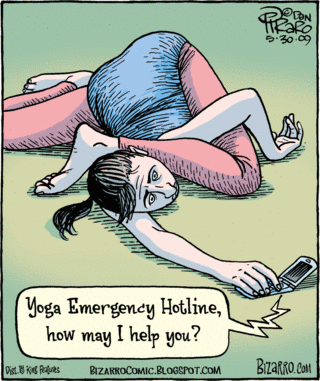Last month, eight colleagues and I faced our Intro II assessment for certification as Iyengar yoga teachers. Before commencing, the assessors asked us about injuries or health issues: “Do you have anything new to report?”
When my turn came, I said, “Nothing new to report.” I entered the exam “healthy.” Secretly, however, I knew my real answer: “Nothing new, except the usual stuff.” In other words, even 100%, I’m always aware of my potential trouble spots.
In the past decade, I’ve sustained one major injury (rotator cuff tear) and a bunch of little tweaks and twinges. I tell myself that active people inevitably sustain minor injuries. But is this true?
 Why are some people “injury-prone”?
Why are some people “injury-prone”?
Have you noticed that some people are inexplicably “injury prone”? Among yoga students, one might report new problems every other week, while another might never mention anything. (This tendency does not correlate with ability or flexibility, by the way.)
My first idea is mindfulness: Do injuries result from preoccupied or scattered behavior? Do people invite accidents? An acquaintance once said that when she finds herself stubbing a toe or stumbling on stairs, it’s a sign that she must pause, take deep breaths, and gather herself.
Next, I wonder if some people are hypersensitive to pain. The same tweaked knee might bother one person more than the next. After all, people vary in tolerance levels for deep massage, intense aerobic training, invasive surgery, freezing weather, and hot chili peppers. Regardless of your sensory awareness/tolerance level, perhaps the main thing is be sensitive during the activity, not after, when it’s too late and damage is done.
The likeliest reason might be overzealousness. Possibly, intense students end up injuring themselves because they willingly, eagerly push to their limits. They never allow R&R, and they ignore warning signs.
Are injuries preventable?
So, can people be intensely active and yet prevent/avoid injuries? My injury history (very abridged sample below) indicates yes:
- Rotator cuff tear A few years ago, I tore two rotator-cuff tendons by slipping and falling on my shoulder. What was I doing? Walking around photographing fall leaves. Instead of bracing myself, I held onto my camera; my shoulder took the hit.
- Hamstring strain Six months post-op, I resumed yoga classes full force. I also volunteered as a student in an Intermediate Junior II assessment (and did more Utthita Hasta Padangusthasana than ever). Soon I felt twinges at my hamstring origins. Too much, too soon.
- Neck/upper back stiffness post Sarvangasana Last month, in the run-up to my assessment, I suddenly tripled my usual Sarvangasana hold, doing recorded timed-practice sequences. Again, intensifying a pose should be done incrementally.
And so forth. Of course, you might be more mindful than I–and still end up injured. I’m not implying that we’re always the perpetrators of our aches and pains! We’re also ruled by genetics and chance. Even fully mindful, stuff happens.
Next: when faced with injury – can it be considered as a personal injury or not (find out details at Costa Ivone, LLC), and what do you do?
Image: Bizarro comic, The Peace Lily
Acknowledgment
This post is dedicated to my colleagues in Vancouver. We all passed our Intro II assessment in April. We couldn’t be more diverse, in body type, age, profession, personality, and birthplace (spanning four different countries!). But we all, in one way or another, have dealt with pain.

Leave a Comment